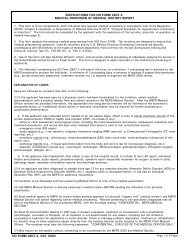INTEGRATED CONTINGENCY PLAN Maneuver Training Center
integrated contingency plan maneuver training center fort pickett ...
integrated contingency plan maneuver training center fort pickett ...
- No tags were found...
Create successful ePaper yourself
Turn your PDF publications into a flip-book with our unique Google optimized e-Paper software.
treatment facility. If a spill were to occur within the facility the surface water flow in this area is<br />
east toward the subsurface storm sewer located south of 10 th Street on Dearing Avenue.<br />
Figure 10 shows the correct placement of a spill boom in the case of a petroleum spill.<br />
Field Maintenance Shop (FMS) #15<br />
The operations at the FMS #15 pose a moderate-to-small potential for spills. The storage located<br />
within this facility that are regulated by 40 CFR 112 are as follows:<br />
500-gallon Diesel Fuel AST: The 500-gallon diesel fuel tank is a single-walled steel tank with<br />
secondary containment. The secondary containment can be drained to an oil/water separator hooked<br />
to the sanitary sewer system. The tank is located on the north end of Building 1556 next to the wash<br />
pad. Storm water drained from the structure is manually diverted to this system to prevent product<br />
release during a tank rupture.<br />
1000-gallon Used Oil Tank: The 1,000-gallon used oil tank is a steel, vaulted AST that meets all<br />
SPCC requirements. The tank is located at the north end of the FMS compound and centrally<br />
located between Building 1556 and Building 1545 under a roofed structure. A spill kit is located<br />
next to the used oil tank.<br />
Hazardous Material Buildings: POLs are stored in three sheds located at the north end the<br />
facility next to the fence line. The POL storage sheds are equipped with adequate secondary<br />
containment for 110% of the largest container stored within the shed. There are approximately<br />
sixty 55-gallon drums and various other containers stored in the three POL sheds. A spill<br />
response center within Building 1556 can be used to respond to any spills that may occur. 55<br />
gallon drums of POLs are also stored in other buildings within the compound that are used by<br />
the 3647 Th Maintenance Company.<br />
FMS #15 Indoor Drainage System: The indoor floor drains are connected to an oil-water<br />
separator that will provide a catch basin for the residual POLs spilled within the building. The<br />
FMS personnel will cleanup any spill POLs with provide spill equipment before cleaning the<br />
maintenance bay. The oil-water separator recovers the waste oils and discharges the waste<br />
effluent to the public wastewater treatment system.<br />
Oil/Water Separator: The wash pad, grit chamber and oil/water separator are at the north end of<br />
Building 1556. MTC-Fort Pickett Facilities Engineering Division maintains the oil/water<br />
separator. This oil/water separator is connected to the sanitary sewer system and the Town of<br />
Blackstone maintains the wastewater treatment facility.<br />
There are no storm water drains on the compound; however, a drainage ditch, located along<br />
Dearing Avenue, provides a migration pathway to a drainage swale, on the east side of Dearing<br />
Avenue. This swale ultimately leads to an intermittent stream that feeds Birchin Creek.<br />
Figure 11 shows the correct placement of a spill boom in the case of a petroleum spill.<br />
MTC – Fort Pickett<br />
Integrated Contingency Plan<br />
Blackstone, Virginia<br />
October 2009 Page 21
















